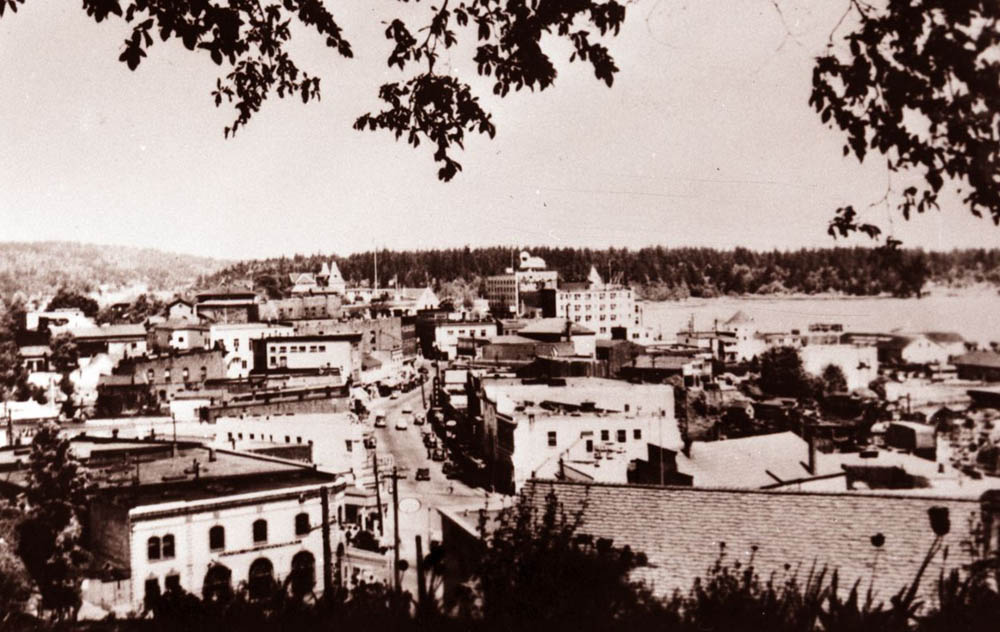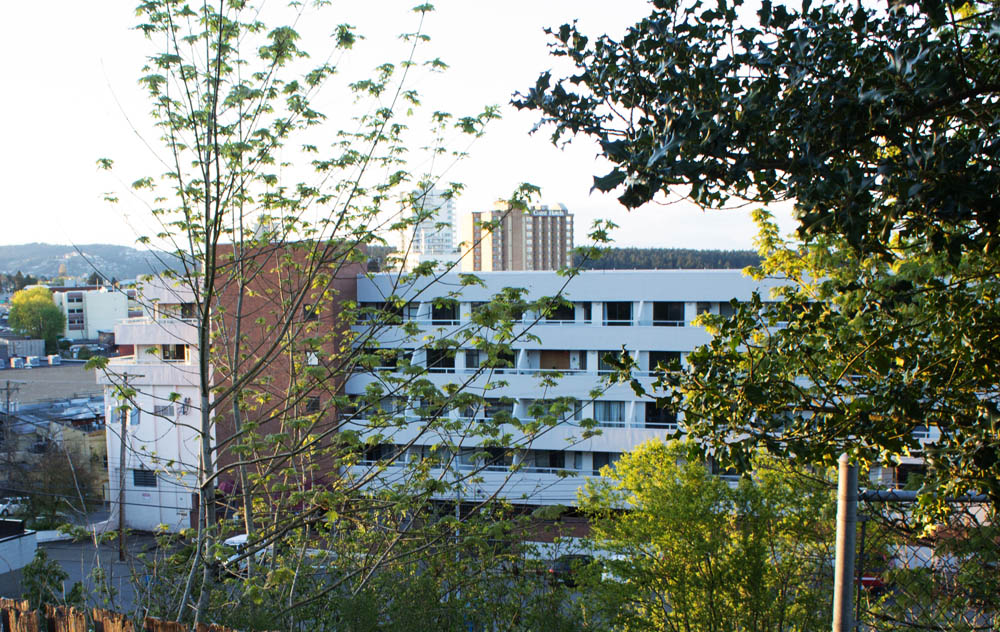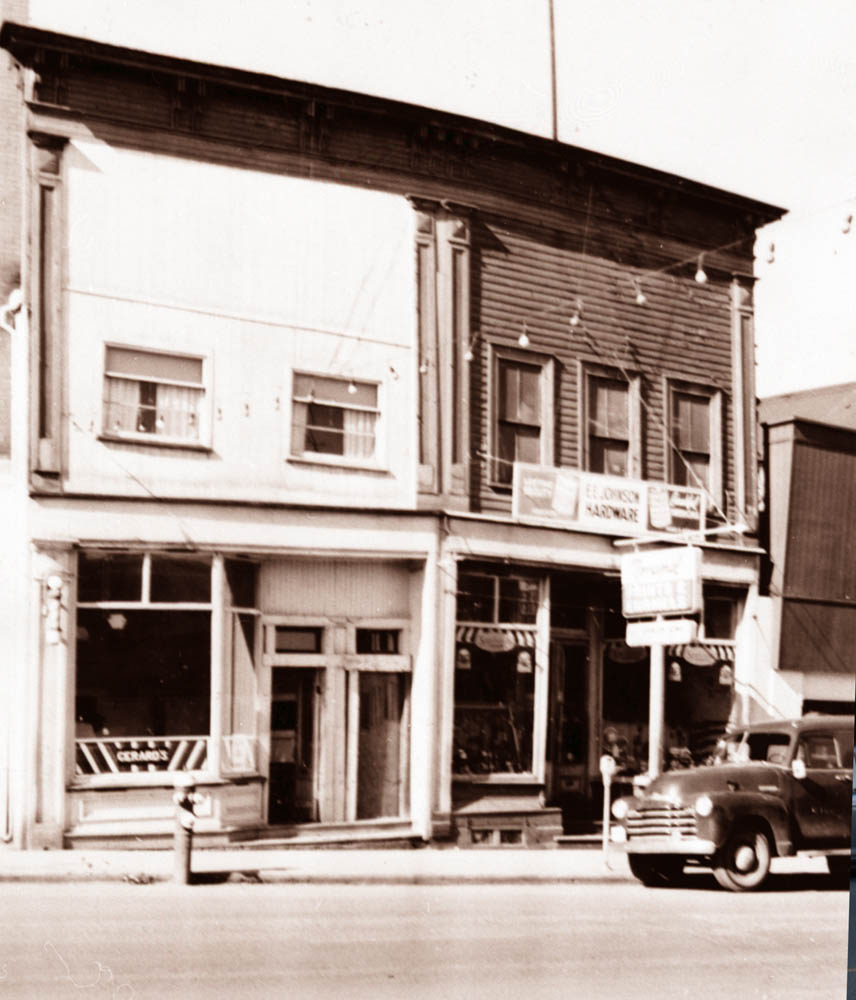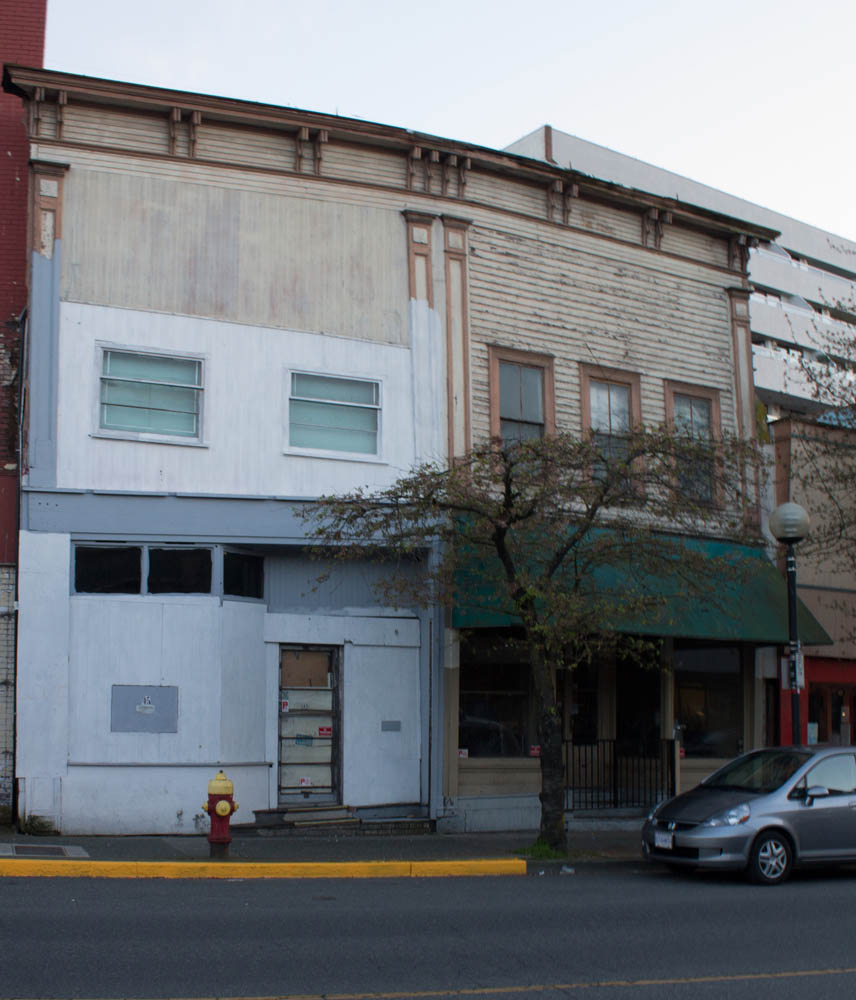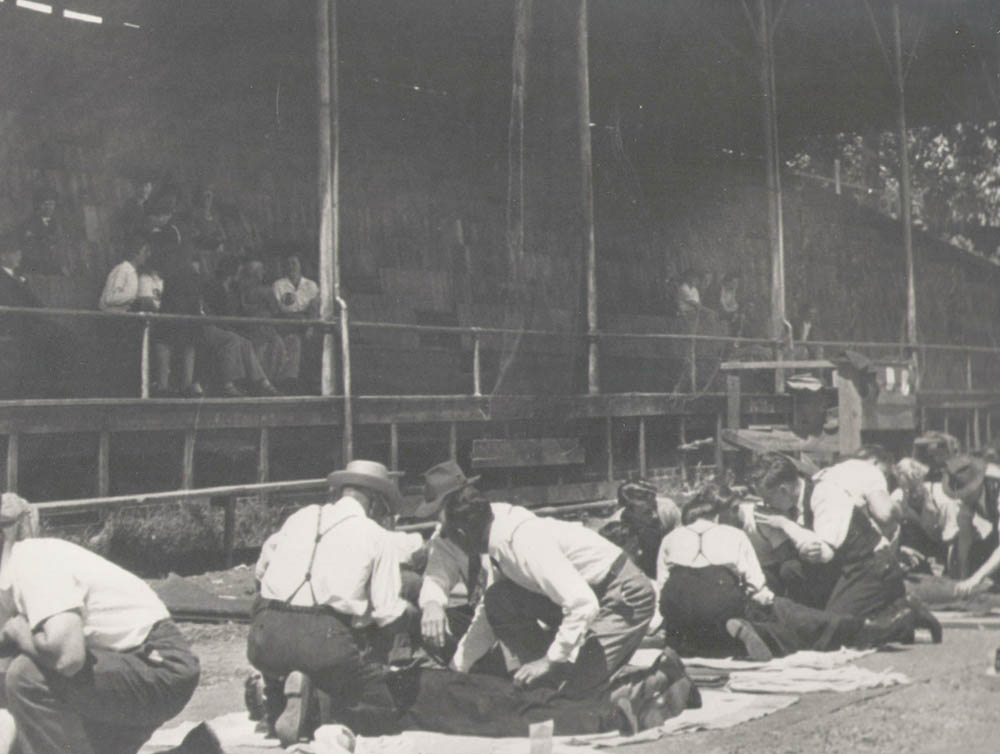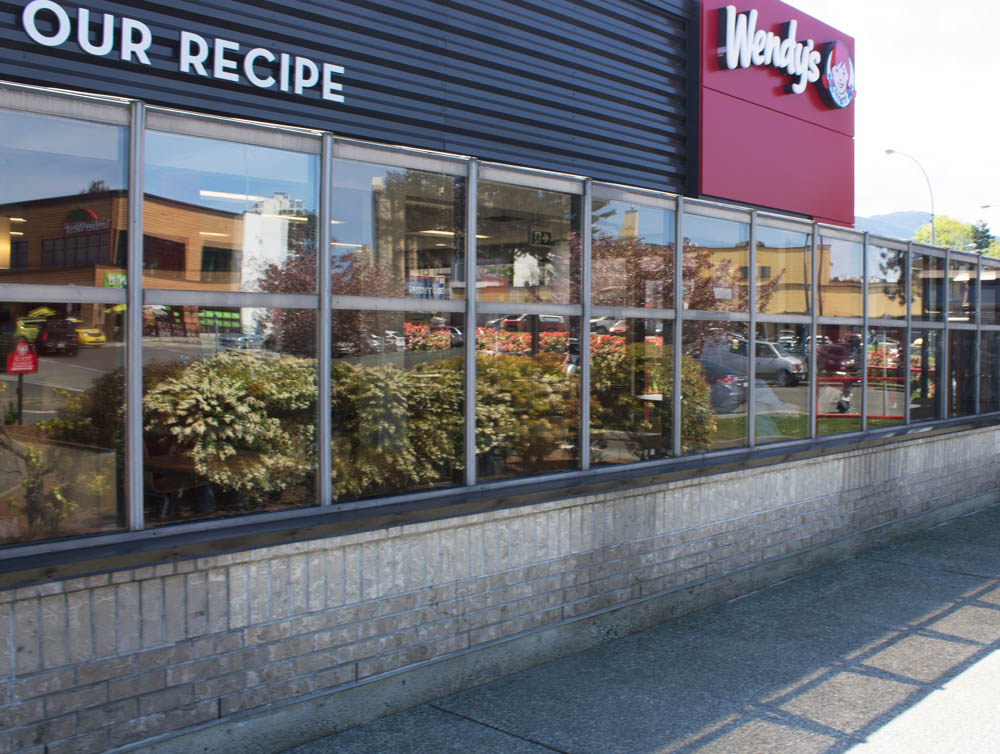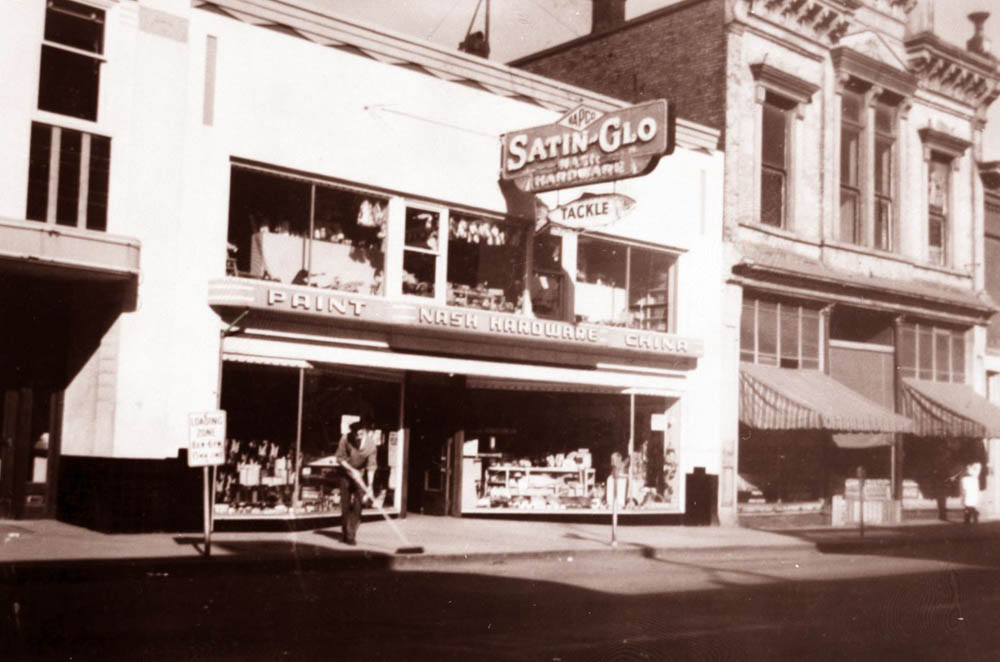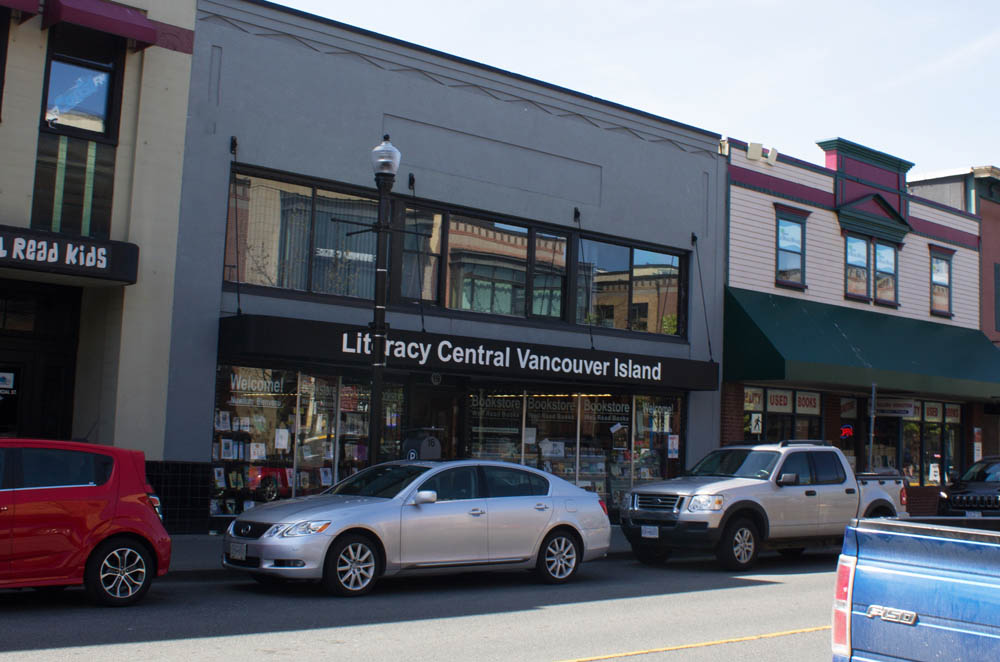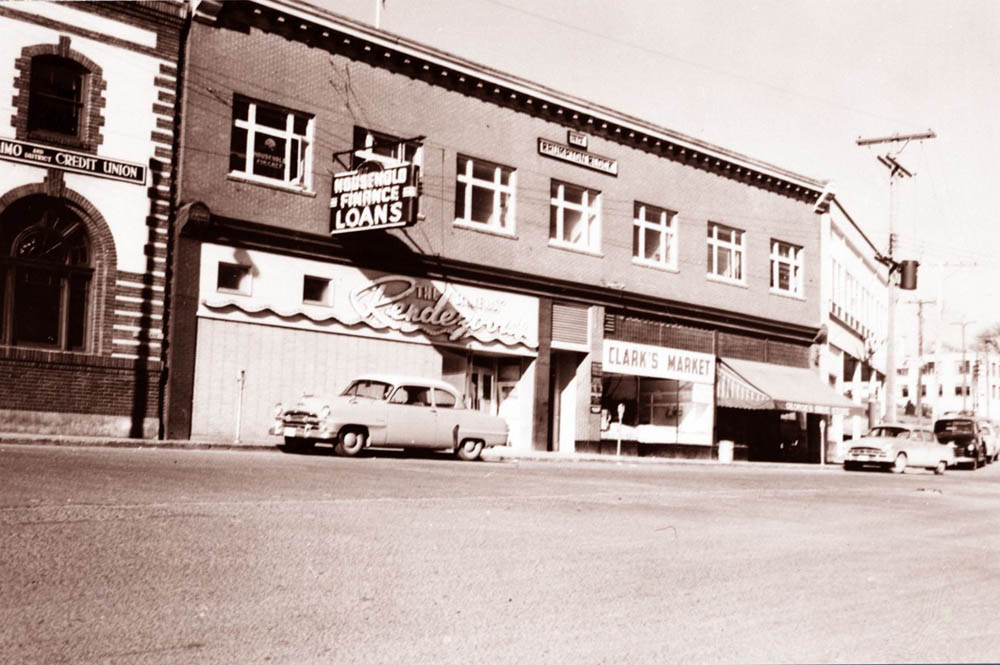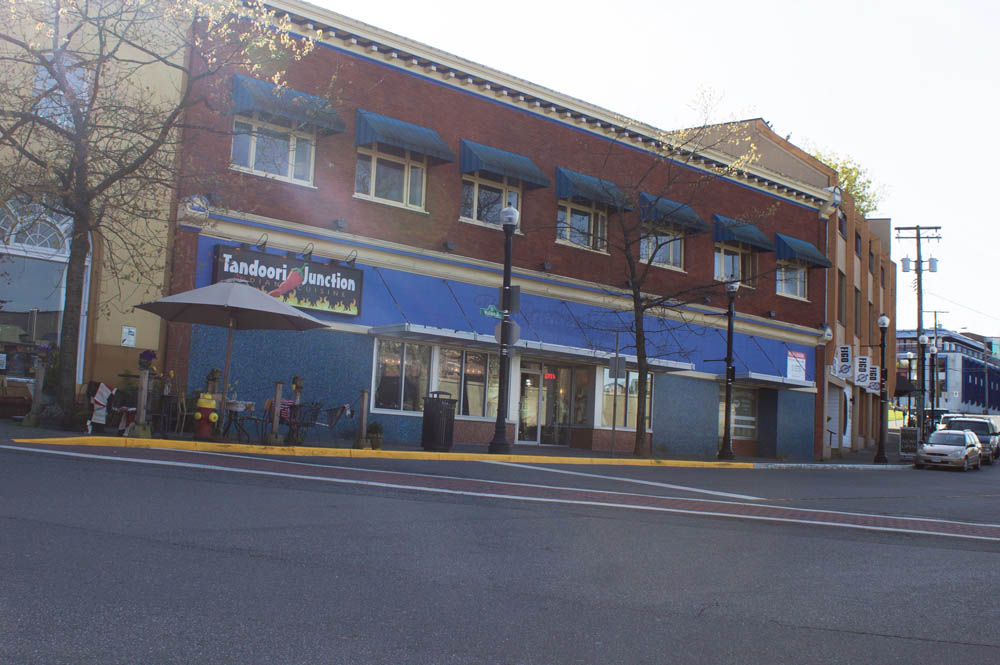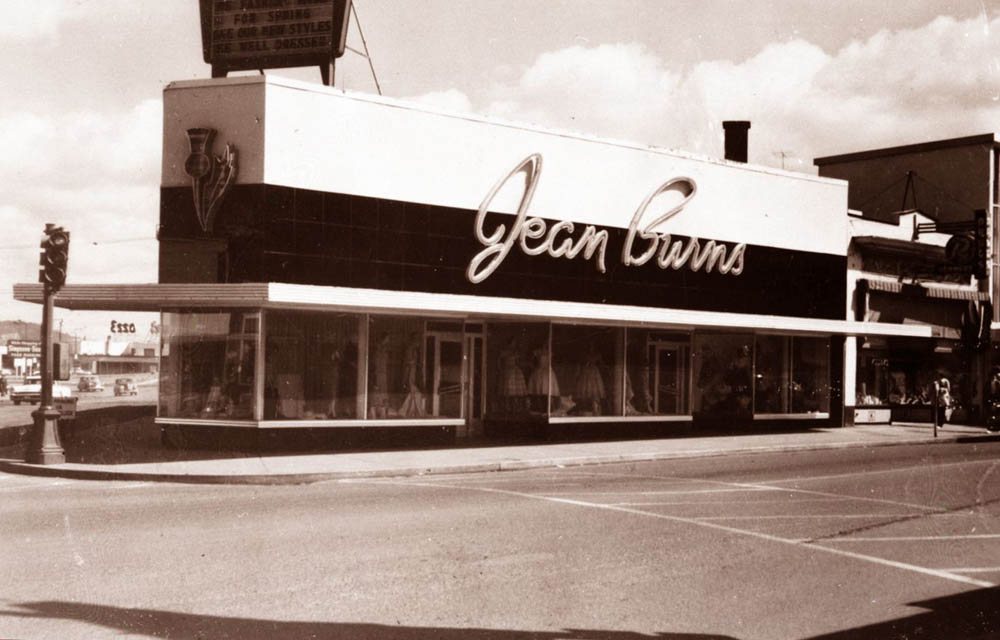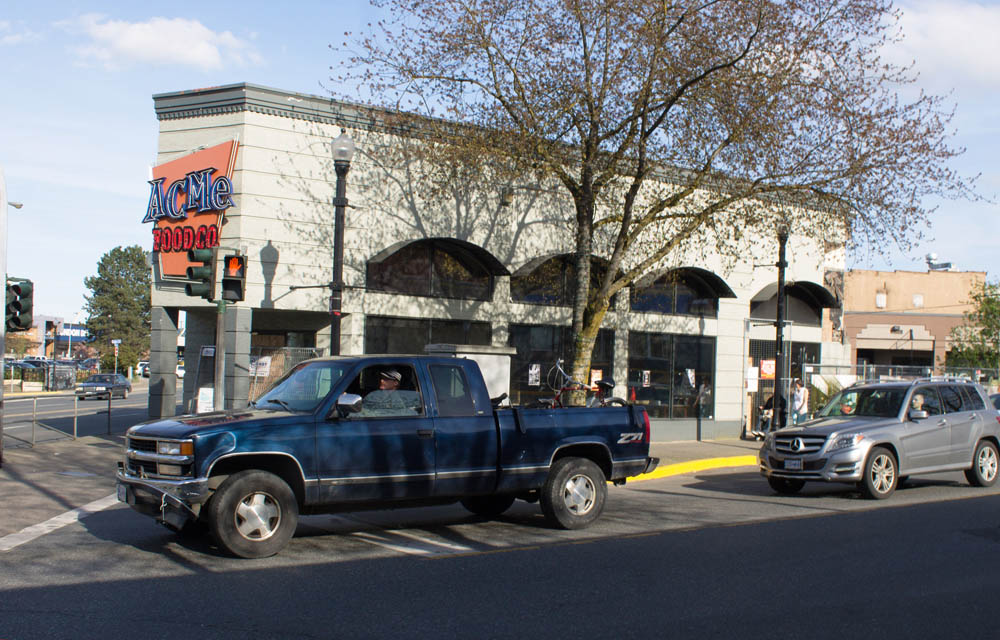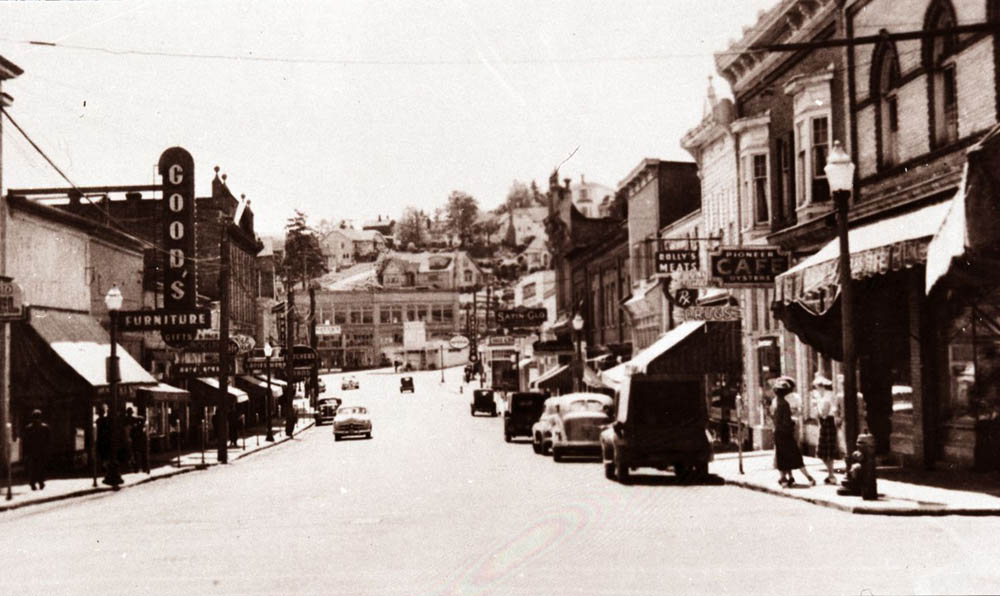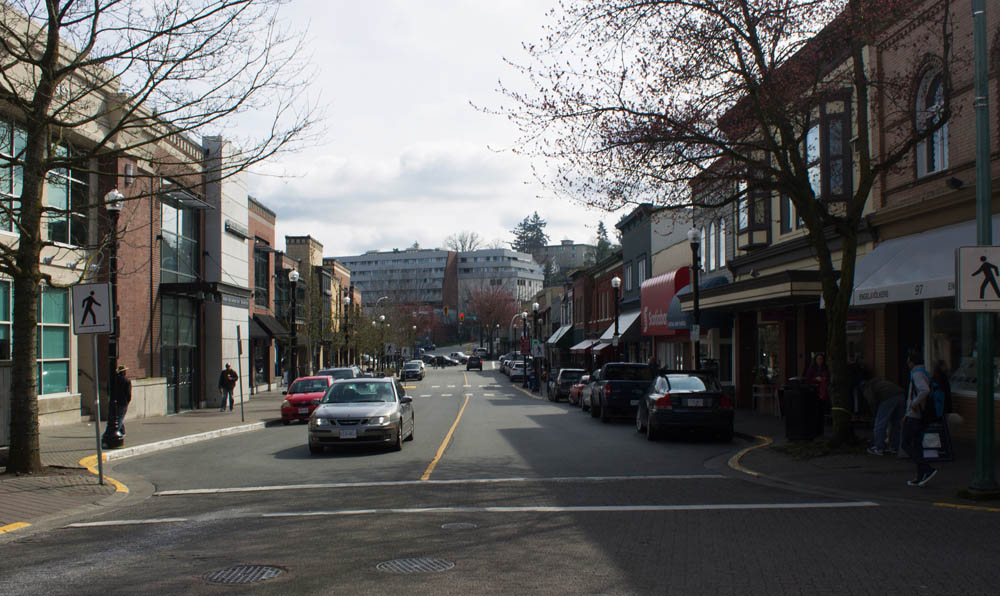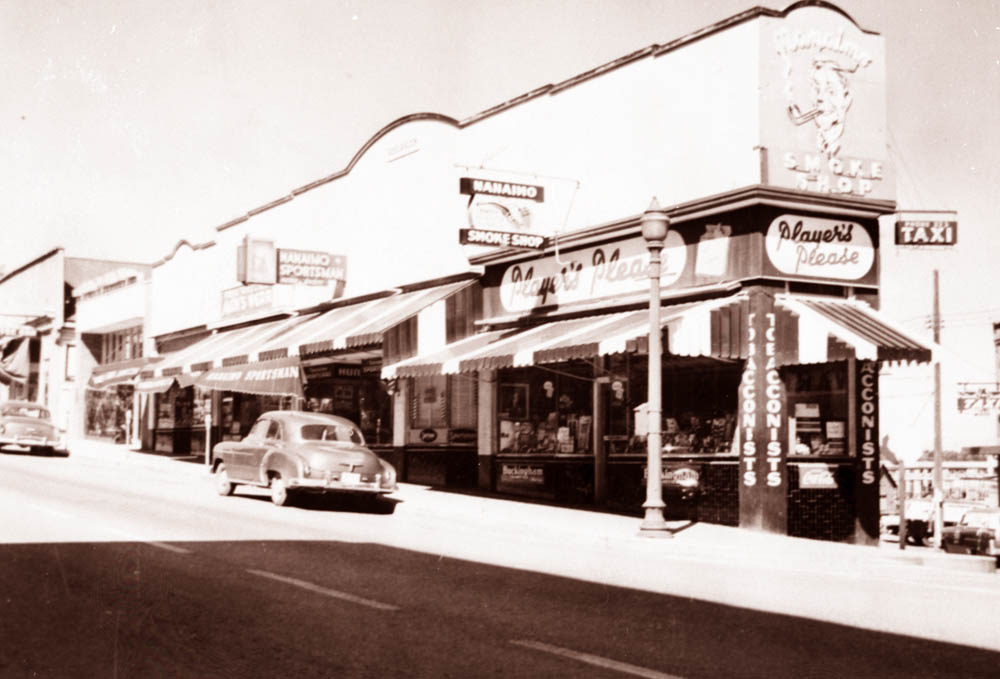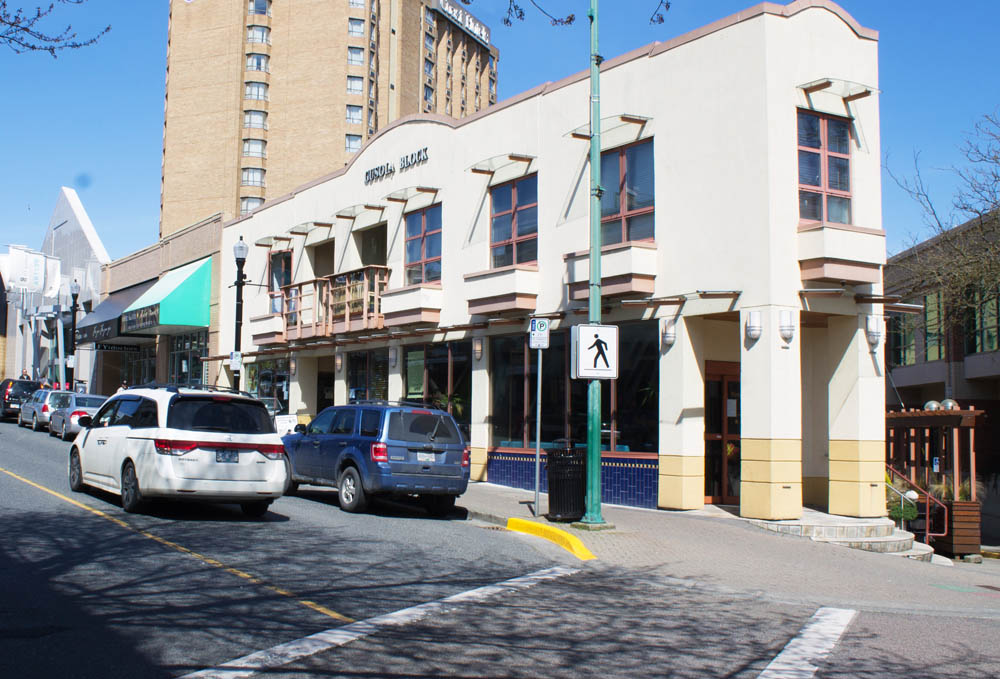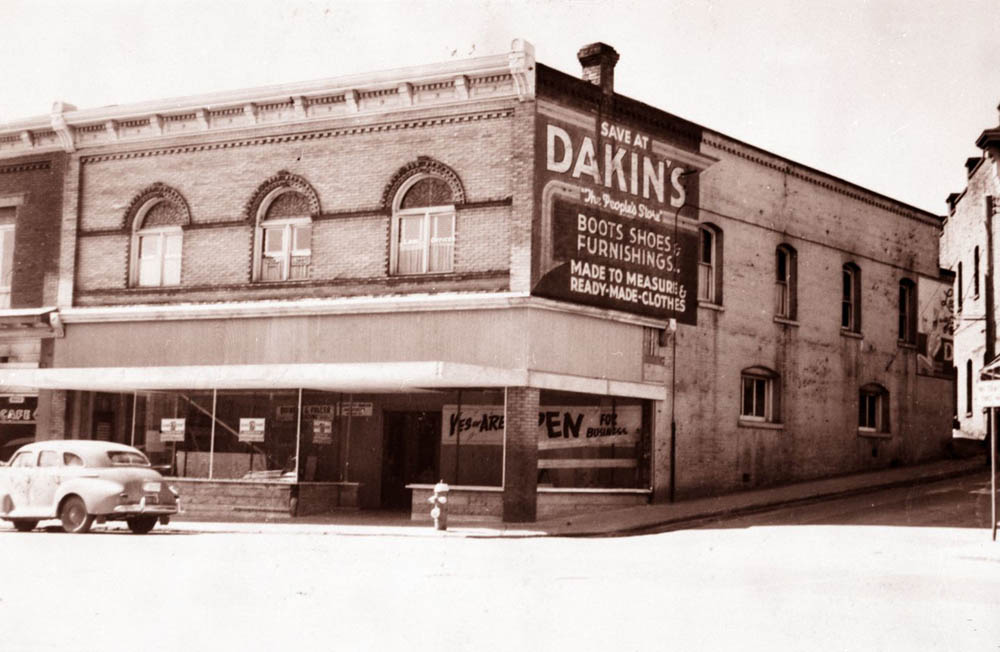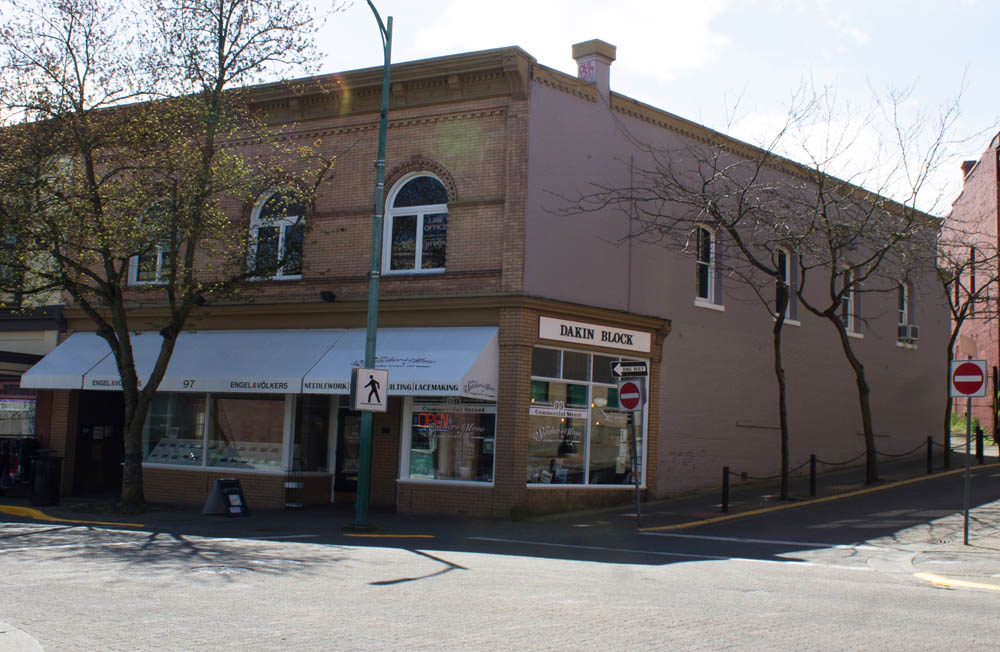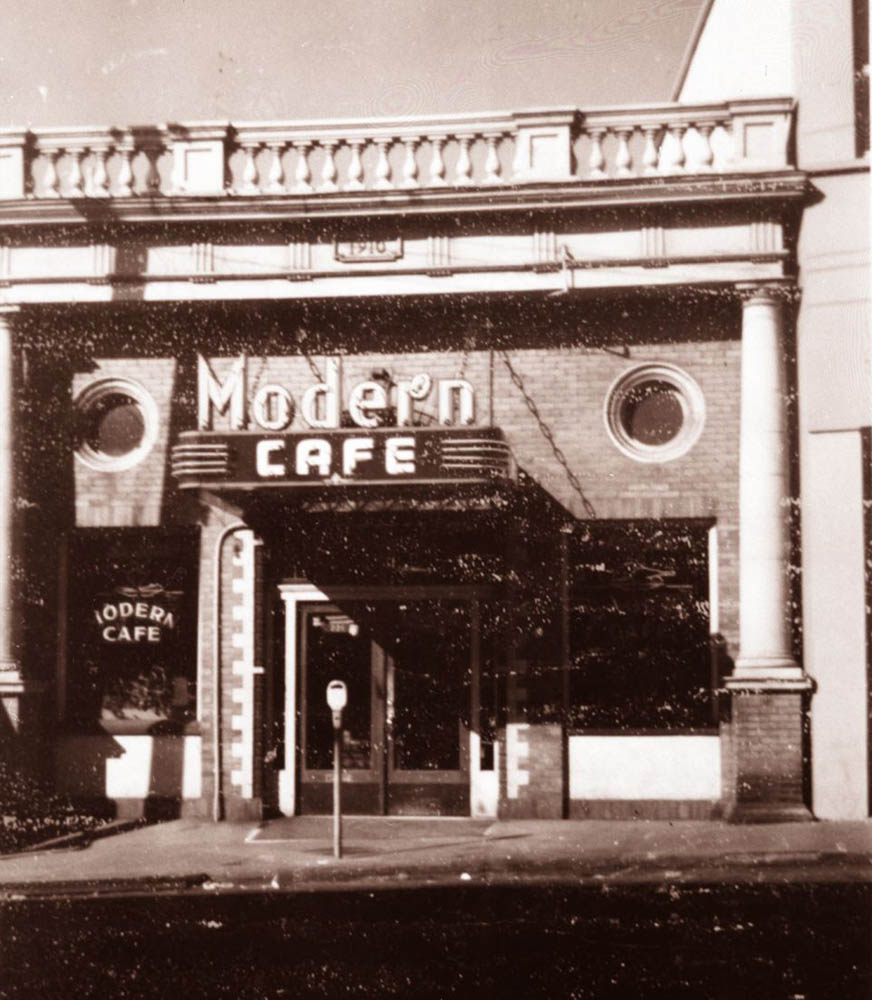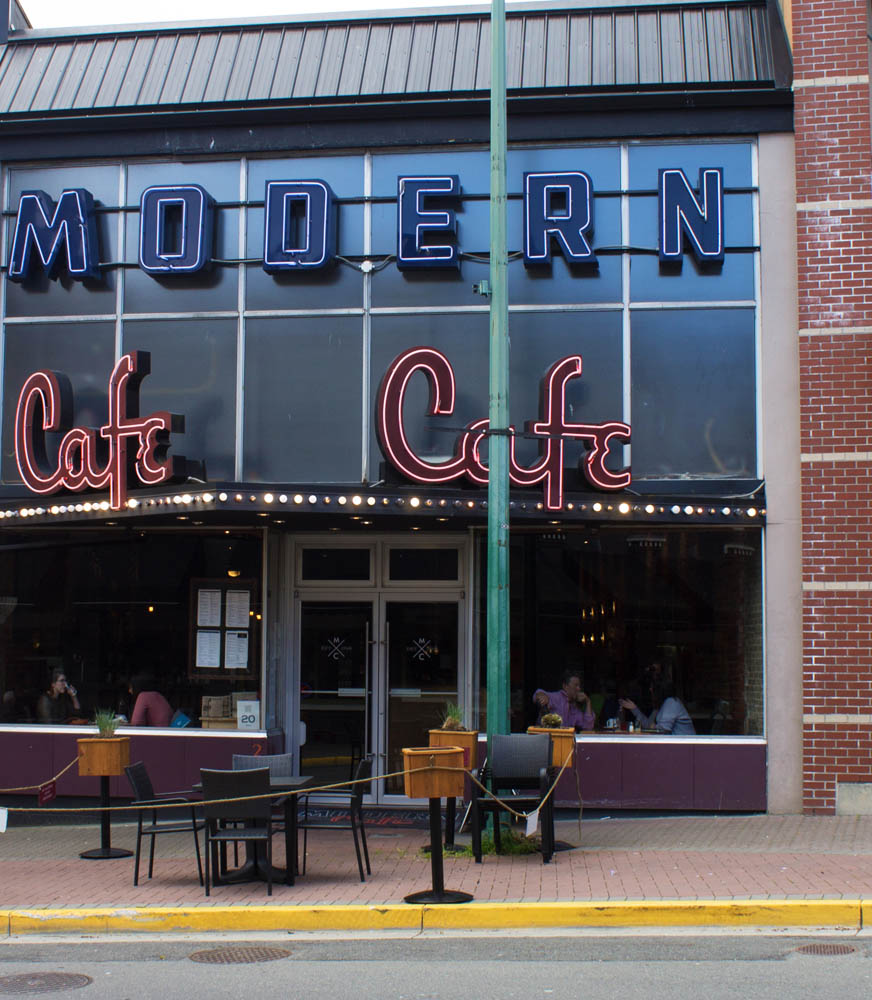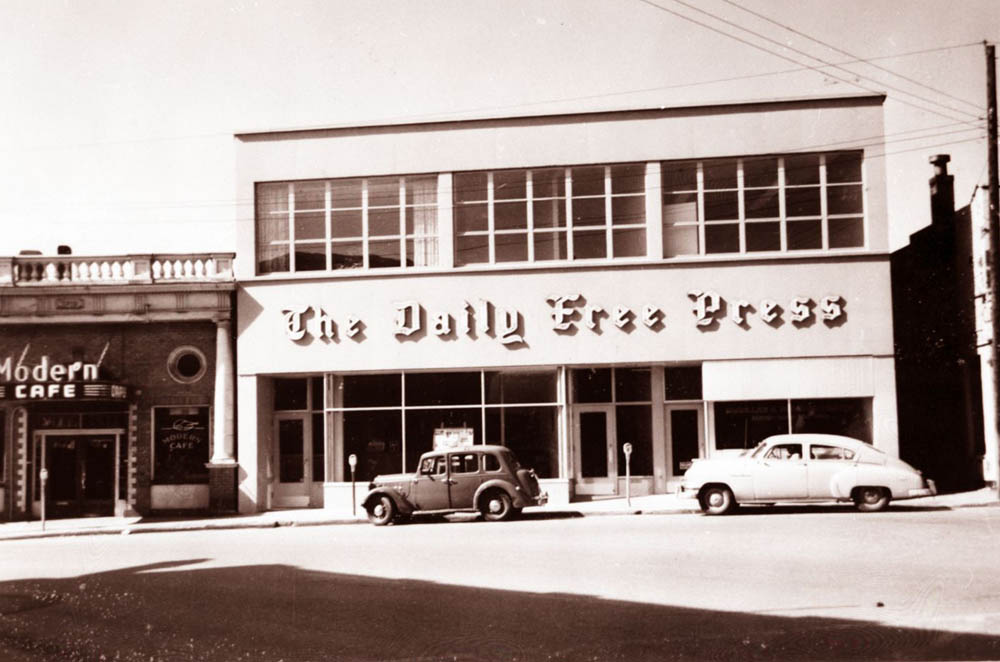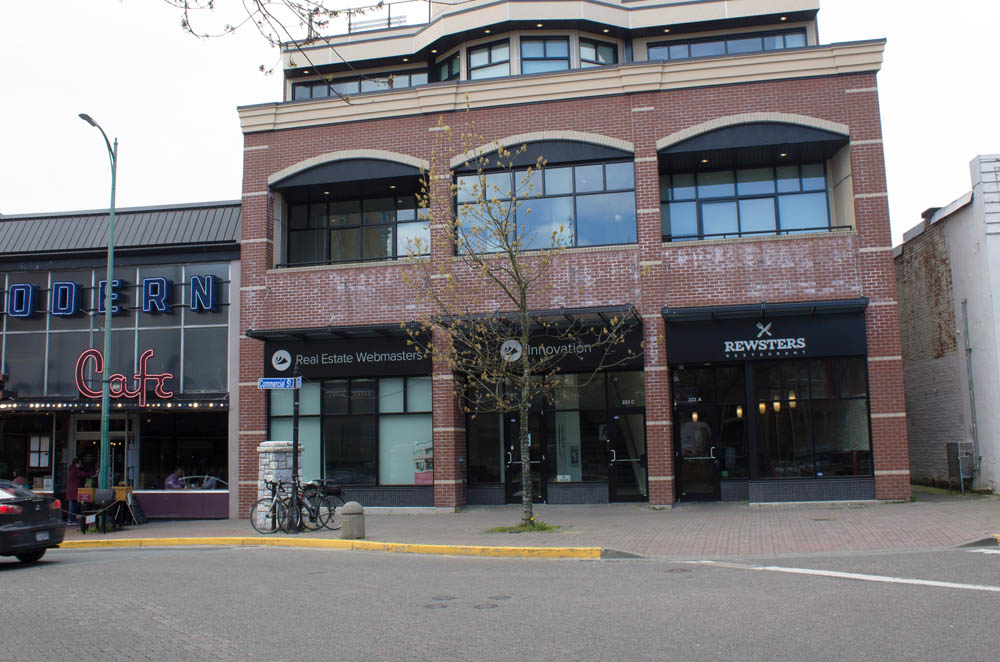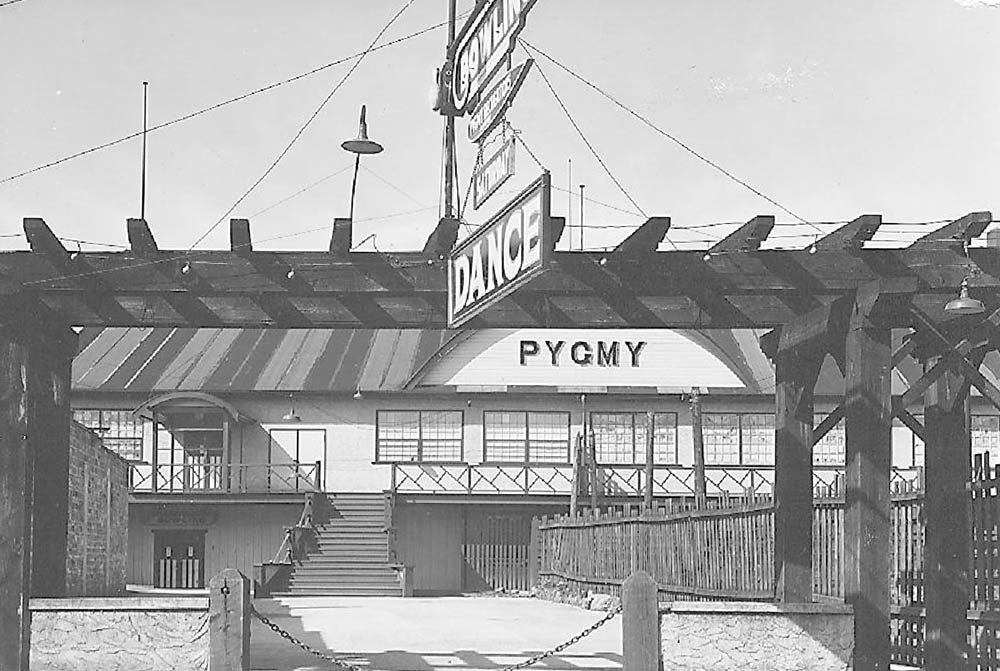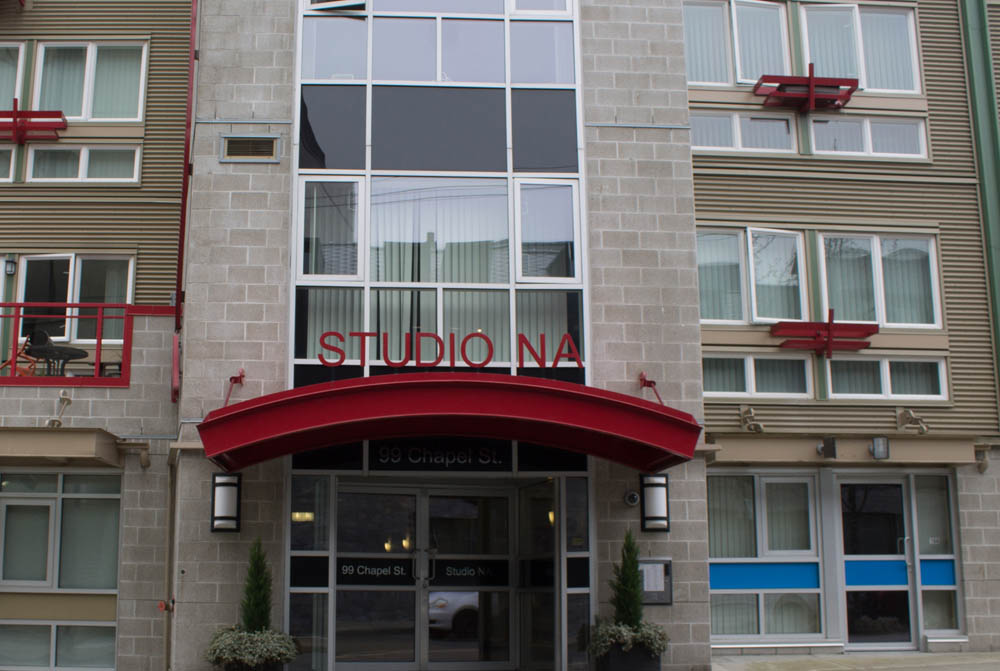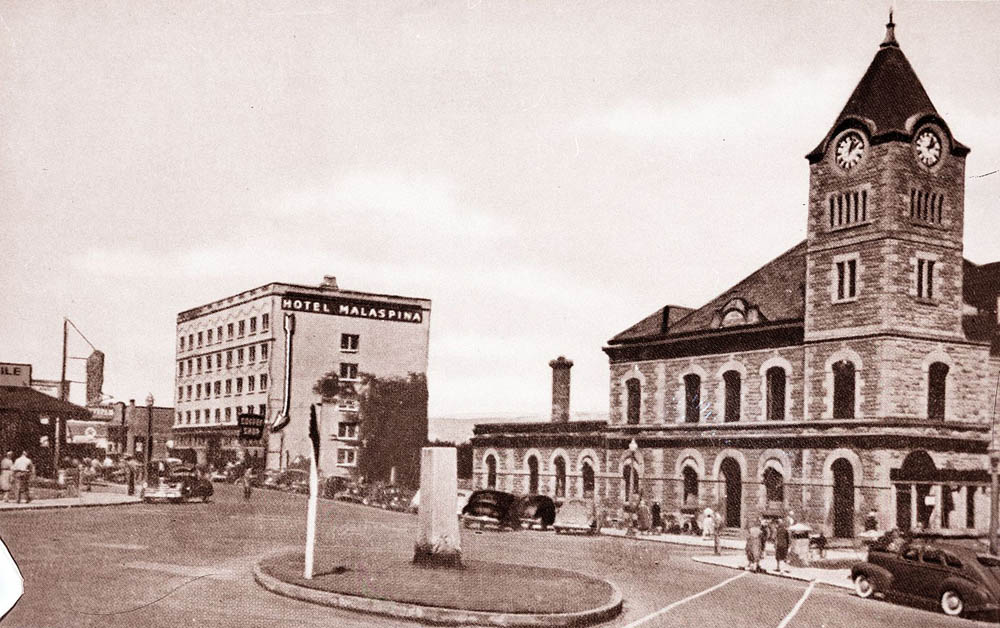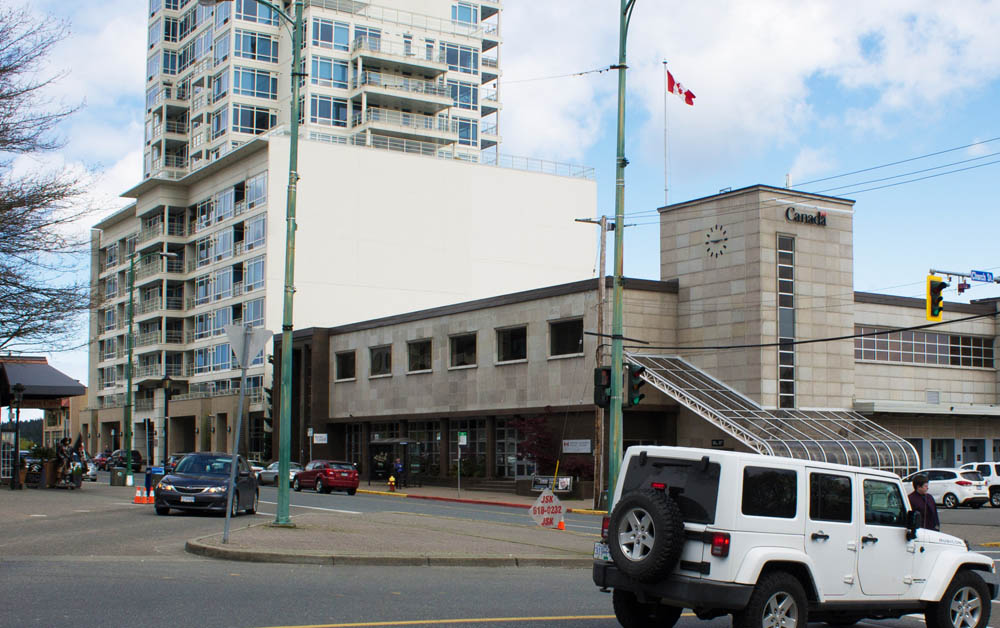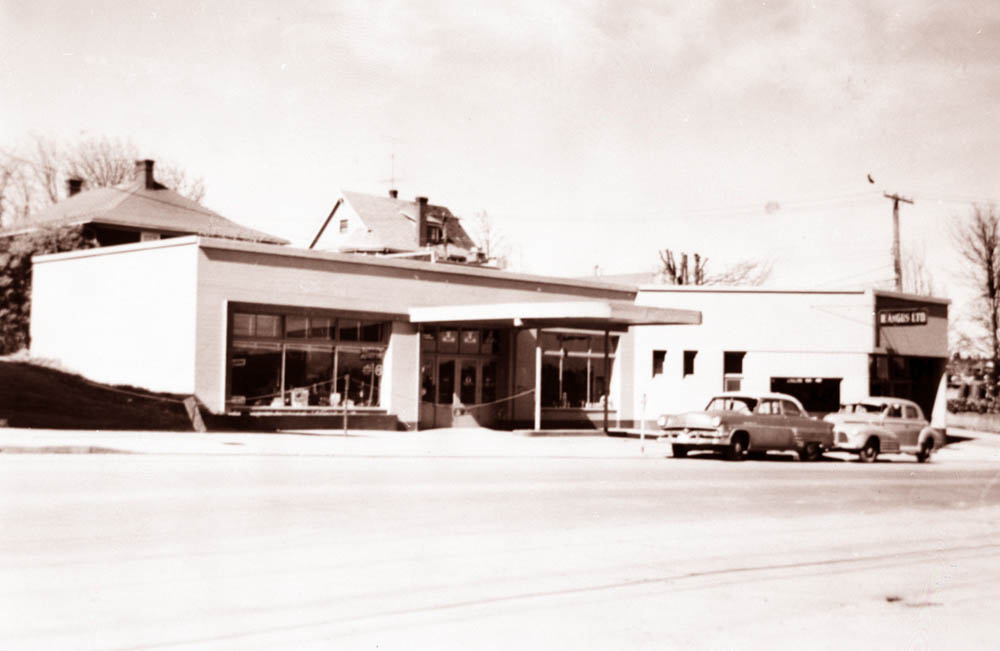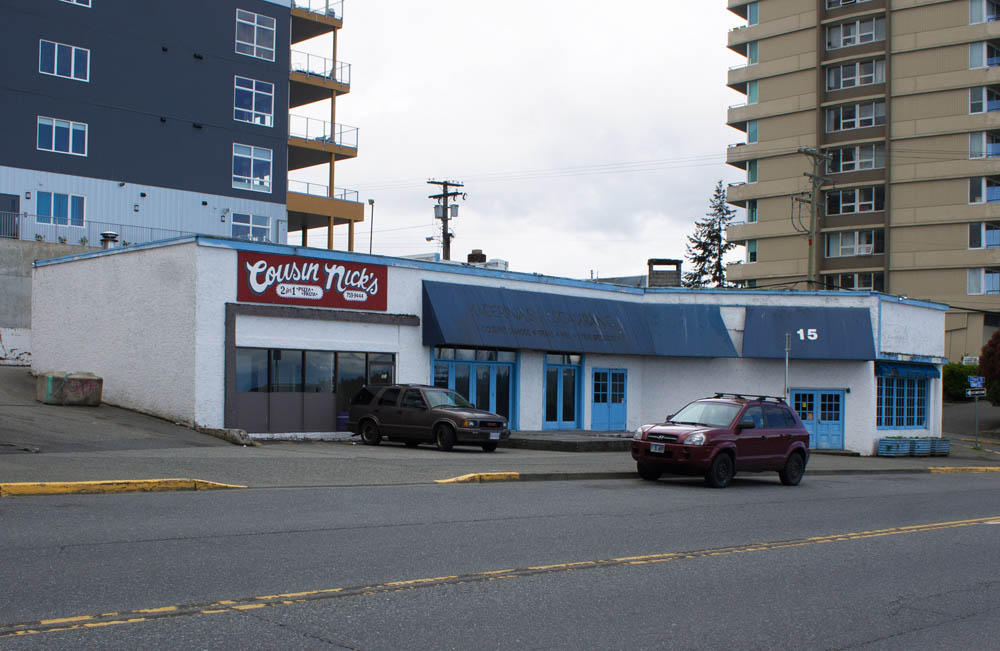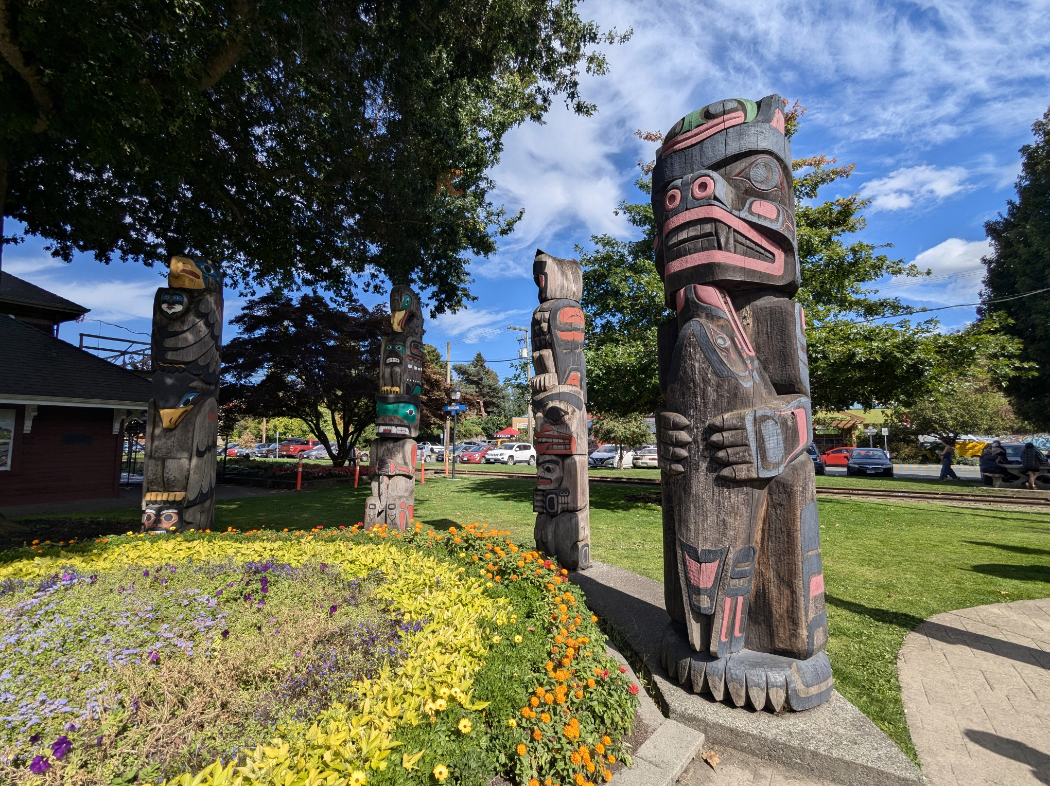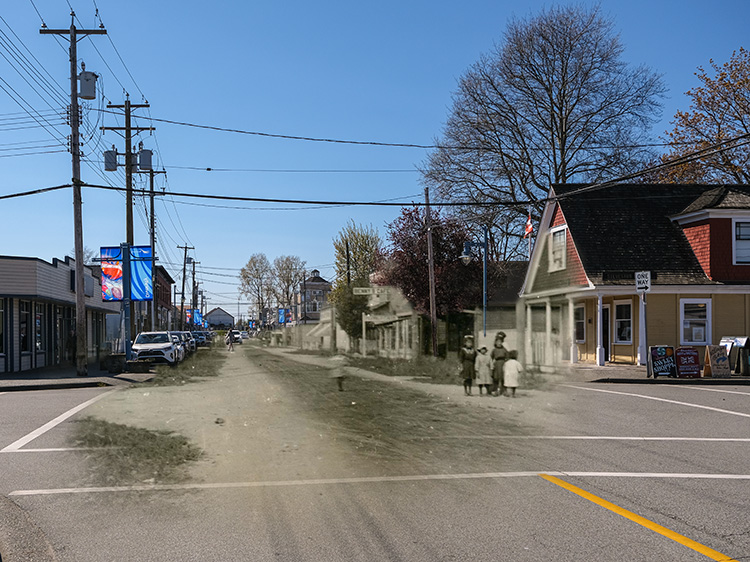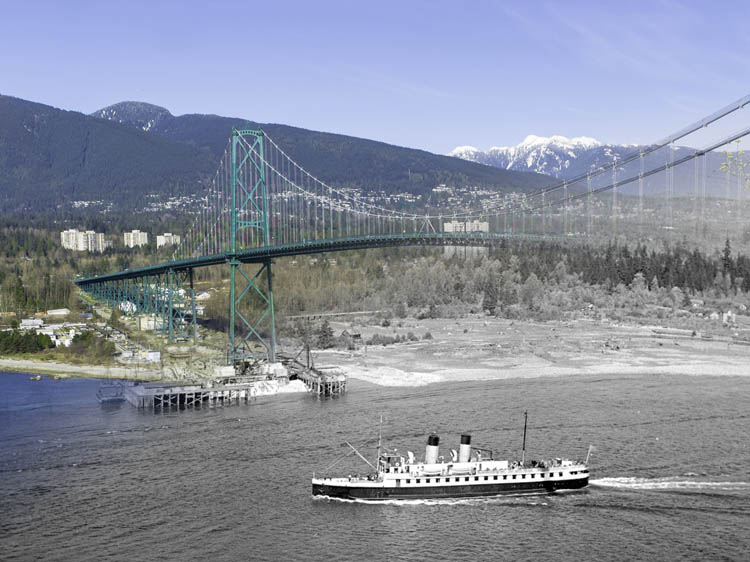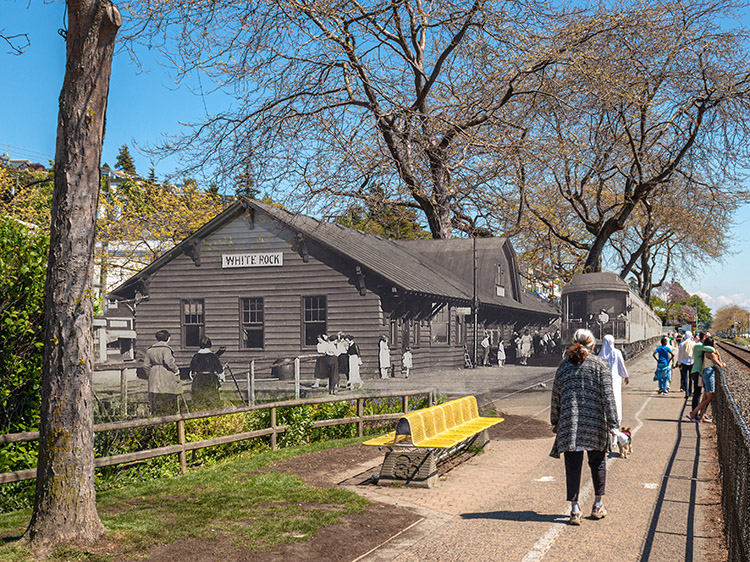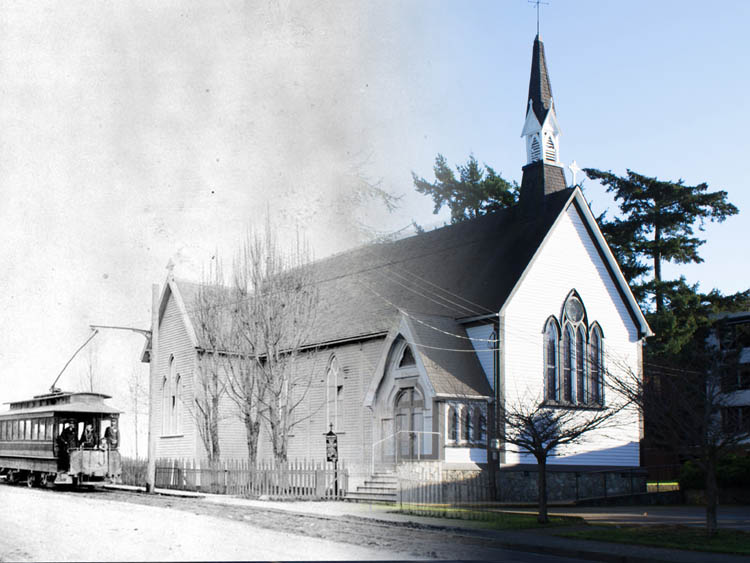Walking Tour
The Boom Years
Nanaimo's Post-War Transformation
By Annabel Howard
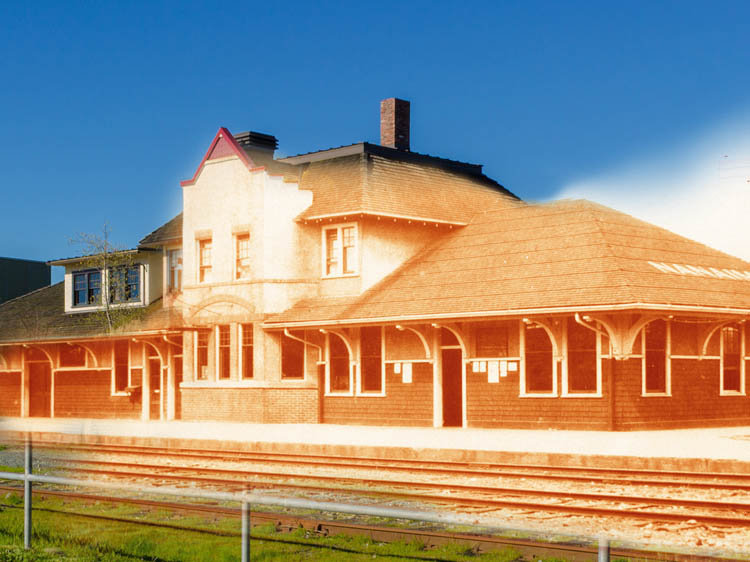
In this tour we will walk through the pivotal years after World War II--when Nanaimo underwent an explosive economic boom that profoundly shaped the city we know today.The late 1940s and 1950s were an exciting time, marked by the creation of new industries, and buildings, and the arrival of new people and ideas. They all contributed to the reshaping of Nanaimo; from a hardscrabble mining town to a major Vancouver Island hub of industry, shopping and culture.
The growth was bolstered by strong held civic values and active government engagement, attitudes that were formed in the trials of the Great Depression of the 1930s and the world wars.
This project is possible with the generous support of the Nanaimo Hospitality Association and the Petroglyph Development Group of the Snuneymuxw First Nation. We would also like to thank the Nanaimo Archives and Nanaimo Museum for use of their historic photo collections and providing research assistance.
1. The Post-war Boom
1940s
The historic photo you see here shows a town poised on the cusp of an economic boom. The 1946 New Year's Day editorial in the Nanaimo Daily Free Press referred to the 'sun of a bright future' on Nanaimo's horizon. It went on to claim that: "Geographically and in resources, Nanaimo's destiny is bound to assert itself, and growth and activity are bound to come here."1 It would turn out that the newspaper's prediction was right on the mark.
* * *
Cars and televisions became the norm rather than the exception. In 1953 only 10% of Canadian households owned a television. By 1965 that figure had skyrocketed to 93%.2 Even flying became accessible: in 1947 Canadian Pacific Airlines established flights in and out of Nanaimo, and by 1953, passengers could travel by plane to Vancouver for a mere $3.45.3
In Nanaimo the post-war period was the one in which a mining town became a major regional hub. Manufacturing and forestry boomed, creating thousands of jobs. By 1948 there were 15 logging companies with offices in Nanaimo, and in 1950 the mill at Harmac opened. Initially they hired 200 workers, but over time they expanded so that by 1970 they employed over 1,000.4
The new business attracted new people to Nanaimo. Immigration, combined with the post-war baby boom, saw the population soar from 19,000 in 1951 to 23,000 in 1956 - a rate that outstripped the rest of the province.5 All the new high-paying jobs that were being created meant people had more money to spend as well, and retail sales increased by 36%--again almost double the provincial rate. This was a hint of Nanaimo's future as a retail hub.6
2. The Depression's Effects
1940s
The post-1945 economic boom was a huge relief for the people of Nanaimo, since they had been suffering through nearly 40 years of war and economic depression. These shops are typical survivors from that period of turmoil where many businesses foundered, and many more shuttered their doors entirely.
* * *
The impact was most keenly felt in the coal industry, which had been the biggest employer in Nanaimo but shrank into insignificance by the tail end of this period. At its peak just after the First World War, the town produced 1.3 million tonnes of coal a year and employed 3,400 miners. That was out of a population of fewer than 10,000. Imagine any single job occupation we have today, and over a third of the entire population are employed doing that single job.
By 1930 the industry figures had shrunk dramatically. Coal extraction had fallen by about half to 755,000 tonnes mined, and only some 2,158 were employed. The steady decline continued and by 1945, Nanaimo's coal industry had more or less run its course: 432 employees mining some 270,000 tonnes of coal, roughly 15% of the peak.2
During the Depression years of the 1930s, when the number of jobs collapsed, the population didn't really grow, but it didn't shrink either. This led to levels of unemployment we'd find difficult to imagine today, even in the aftermath of the COVID-19 pandemic.
By the end of the 1920s the first bread lines appeared. Then the situation began to quickly escalate. Across British Columbia in 1930 some 7,000 men were on relief, an unprecedented and gigantic jump from just a year earlier. By 1932, two years later, there were almost tenfold as many men on relief. By 1933 there were 100,000 unemployed, meaning a 31% unemployment rate, or one in eight members of the province's entire population—once again including women, children and the elderly in that total.3
We in the 21st Century have experienced a lot of economic chaos in our lifetimes, but the statistics are a sobering reminder that we haven't approached the depths plumbed during the Great Depression. No wonder images of the town from the town look and feel demoralized.
The Federal Government, initially slow to respond to the Depression, was instrumental in providing funds for major building projects that would put the unemployed back to work. These included the lumber wharf, the Bastion Bridge, and the Civic Arena. Before the Depression few people saw much role for a proactive government in the economy, but these Depression era projects were critical for stimulating the economy in those dark times. They established the model for the government to take more muscular measures in the economy after the Second World War. This would prove critical for fuelling that post-war economic boom.
3. The End of the War
Nanaimo Community Archives 1996 034 A-P286
1940
This photograph shows a first aid practice drill taking place in the centre of Nanaimo. A real turning point for the city came when the Air Raid Precaution sirens rang out around Nanaimo at 7:10 am on May 8, 1945. They were not warning of a bombing raid, but the end of the war in Europe, VE Day.
* * *
The war might have been over, but its shadow lingered. Sixty residents of Nanaimo had been killed, war ships still roamed the coast, and memories of rationing were raw and recent. Gas and sugar had been ration ed since 1942, when consumption of sugar was limited to half pound a week per person. In 1943 this was followed by meat, with "meatless Tuesdays" introduced at restaurants. Life was tough, with wages capped, prices controlled, and income taxes increased ten fold to help fund the astronomical expense of the war.
The end of the war was therefore a time for celebration. After the sirens sounded the city declared a civic holiday. The Nanaimo Daily Free Press described VE Day, saying "It was a sunshine-swimming morning with all hearts gladdened.' The city didn't look back.
4. The Modern Aesthetic
1940s
The Nash Hardware Store was originally built in 1909, but its 1945 Art Deco facelift (pictured here) was just one symptom of growing optimism in Nanaimo.
* * *
5. The Nanaimo Credit Union
1950s
One of the major factors fuelling Nanaimo's great 50s economic boom was the Credit Union, seen on the left side of this photograph. Started by a small group of 17 in 1945, it grew rapidly and, from 1955, occupied this prestigious building, designed by Francis Rattenbury, the renowned architect of the Victoria Parliament buildings and the Empress Hotel.
* * *
A sense of the new dynamism taking hold in Nanaimo can be gleaned from Credit Union's records: 30% of loans went towards construction materials, for building homes. A further 20% were for vehicle purchases or repairs. 16% went towards household furnishings and appliances, with 10% being requested for boats or farm machinery. The remainder went towards living expenses: tax, insurance, medical bills, dental fees, and the costs of getting married.1
6. New Fashions
1960s
Like the Nash Hardware store, the original Jean Burns Ladies and Children's Shop that once stood on this site was emblematic of forward-looking, 50s Nanaimo.
* * *
7. The Power of Shopping
1950s
This view up Commercial Street gives a good sense of Nanaimo's busy shopping district. The presence of women and children is notable, and is indicative of the social changes that helped to drive growth and prosperity.
* * *
Nanaimo was quick to understand the importance of retail to the post-war economy. A 1951 report by the Bureau of Economics and Statistics recommended that 'Future planning in Nanaimo should recognize the importance of retail and wholesale trade to the area's economy and should include provision for smooth vehicular movement and adequate parking."2 The city listened: by the mid 50s Nanaimo had "more retail space per capita than any other city in North America."3 The openness to consumption encouraged the process of modernization, and helped to engage women in public life and space. Apart from shops, women were encouraged to engage through libraries, cinemas and restaurants, some of which can be seen in this historic photograph.
8. The Tobacconist
1950s
Taken at the bottom of Commercial Street, this brightly lit scene shows a familiar 50s sight: the local tobacconist, in this case selling famous Player's Please cigarettes.
* * *
9. Dakins Menswear
1950s
Dakins store– something of a male answer to Jean Burns—is seen here open for business in the 1950s with its large sign and partially renovated facade.
* * *
Besides this shop Dakin, a dynamic business man, became one of the organizers for the community fund-raising efforts that eventually led to the construction and opening of the Hotel Malaspina in 1927. 93-99 Commercial St., built 1911, is now named the Dakin Block after him.
10. The Modern Cafe
1940s
The Modern Cafe's loud and familiar neon sign is the latest iteration of a sign that's stood on this building since the mid-1940s. It, like the cafe itself, has since become a Nanaimo institution.
* * *
11. The Daily Free Press
1950s
Next to the Modern Cafe stands Nanaimo's Daily Free Press: an integral part of Nanaimo life, which went a long way to shaping the town's character and ushering it into post-war modernity.
* * *
During the war, this building played a key role as the location of the city's air raid siren and, of course, the main source for news about the war. At the end of the war, the paper evolved, but maintained its stated aim of informing readers, holding officials to account, and (once those two were accomplished) entertaining.1
It finally closed its doors in 2016, to much local regret. Philip Wolf, managing editor at the time said, accurately: "We chronicled the mine disasters and world wars, presidential assassinations and everything in between... This paper has had an impact on the lives of pretty much every single person in Nanaimo."12
12. The Dance Halls
Nanaimo Community Archives 2013 010 A-P32
1950s
Al Campbel, a big band musician, recalls what it was like at the Pygmy Pavilion, the most popular local dance hall. "Back in the 1930s, 1940s and early 1950s, as many as 1,000 people crammed onto the dance floor for a little jump, jive, and wail.... I remember soldiers coming in for Saturday night dances.... We would go until 2:00 am."
* * *
The Pygmy was outfitted with a spring-loaded dance floor and attracted large audiences as well as jazz musicians from all over the world. This was where Louis Armstrong played, with his 18-musician orchestra, in 1943.
By the late 50s, big band music had been supplanted by rock'n roll, and an explosion of youth culture that accompanied the security and prosperity of that era. The Pygmy band moved out of the Ballroom into the nearby Legion Hall, and the Ballroom itself was converted into the bowling alley seen in this historic photograph.
13. Front Street's Evolution
1940s
This historic photograph is a microcosm of 1940s Nanaimo on the cusp of change. In the background stands the Malaspina Hotel, surrounded by the cars of the visitors it was intended to attract. In the foreground looms the post office – one of Nanaimo's earliest buildings. It was destined to be demolished in 1954.
* * *
In the foreground of this photograph stands the Nanaimo Post Office, designed by the architect Thomas Fuller and completed in 1884. In the 50s the city was advised by the government that a new federal building would replace the old. Some Nanaimoites defended the old post office, and the Daily Free Press quoted city engineer W.A. Owen's plea to preserve the old building: "Is there no last minute persuasion that can be directed to avert the destruction of this splendid building...? The Post Office building is a building that has been very intimately tied to Nanaimo's history for 65 years. It is a landmark that can never be repeated."2
Despite resistance, the post office was pulled down in 1954, and replaced by the new Post Office and Federal Building, which opened in 1956. The building, designed by Chief Architect E.A. Gardner, is another beautiful manifestation of the International Modern architectural style that produced so many of Nanaimo's 50s facades.
14. The Car Society
1950s
How appropriate to finish this tour with a gas station – the quintessential symbol of the post war boom.
* * *
The gas station in this photograph is typical of the type of building that serviced the automotive sales and services industry in Nanaimo from the 1920s to the 1960s.1 . The building in the historic photograph is still visible today beneath its contemporary cladding. When it was built it was cutting edge, an industrial take on the International Modern style that reflected the industry's mechanical roots.
Early gas and service stations were built right up to the edge of the road, and the gas pumps were put on the sidewalk, or sometimes even on the road itself. This building, with its setback from the sidewalk to allow for parking, reflects new considerations for cars being taken in building design in that period.
We hope you enjoyed this tour of Nanaimo's Postwar Transformation. We encourage you to check out some of the many other tours and then and now photos we have across Nanaimo.
Endnotes
1. The Post-war Boom
1. Patrick A Dunae, Excelsior! History of a Credit Union 1946-1996 (Oolichan Books, 1996), 10.
2. Penny Tinkler and Cheryl Krasnick Warsh, "Feminine Modernity in Interwar Britain and North America: Corsets, Cars and Cigarettes" (Journal of Women's History, Vol 20, No 3, Fall 2008).
3. Jan Peterson, Harbour City: Nanaimo in Transition 1920-1967 (Surrey: Heritage House Publishing Company, 2006), 140.
4. Dunae, Excelsior, 10.
5. Peterson, Harbour City, 29.
6. Dunae, Excelsior, 10.
2. The Depression's Effects
1. George Woodcock, Picture History of British Columbia, 88.
2. Woodcock, Picture History of British Columbia, various.
3. Jan Peterson, Harbour City, 102.
4. The Modern Aesthetic
1. City of Nanaimo, "Nash Hardware" (Online).
5. The Nanaimo Credit Union
1. Dunae, Excelsior!, 11.
7. The Power of Shopping
1. Tinkler and Warsh, "Feminine Modernity in Interwar Britain and North America".
2. Dunae, Excelsior!, 25.
3. Peterson, Harbour City, 198.
11. The Daily Free Press
1. Spencer Anderson, "Daily newspaper has long, storied history in Nanaimo," Nanaimo Daily News, Jan. 26, 2016 (online).
2. Chris Bush, "Paper Chronicled Nanaimo's history", Nanaimo Bulletin, Jan. 27, 2017 (online).
13. Front Street's Evolution
1. Peterson, Harbour City, 54.
2. Peterson, Harbour City, 177.
14. The Car Society
1. Statistics Canada, (Online)
Bibliography
Anderson, Spencer, "Daily newspaper has long, storied history in Nanaimo," Nanaimo Daily News, Jan. 26, 2016, accessed June 24, 2017. http://www.nanaimodailynews.com/ourtown/366586331.html
Barman, Jean. The West Beyond the West: A History of British Columbia, U. of Toronto Press, 1991.
Belisle, Donica. Retail Nation: Department Stores and the Making of Modern Canada, UBC, 2011.
Bush, Chris, "Paper Chronicled Nanaimo's history", Nanaimo Bulletin, Jan. 27, 2017, accessed June 24, 2017. http://www.nanaimobulletin.com/news/paper-chronicled-nanaimos-history/
Duane, Patrick A. Excelsior! History of a Credit Union 1946-1996, Oolichan Books, 1996.
Gidney, Norman. "From Coal to Forest Products: The Changing Resource Base of Nanaimo," Urban History Review. No. 1-78, June 1978. \
"Nash Hardware", City of Nanaimo, accessed June 17, 2017. http://www.nanaimo.ca/PRC/CulturalMap/Details/459-Nash-Hardware/
Peterson, Jan, Harbour City: Nanaimo in Transition 1920-1967. Surrey: Heritage House Publishing Company, 2006.
Peterson, Jan, Hub City: Nanaimo 1886-1920. Surrey: Heritage House Publishing Company, 2003.
Tinkler, Penny & Warsh, Cheryl Krasnick, "Feminine Modernity in Interwar Britain and North America: Corsets, Cars and Cigarettes," Journal of Women's History, Vol 20, No 3, Fall 2008.
Woodcock, George. Picture History of British Columbia, Alberta: Hurtig Publishers, 1980





